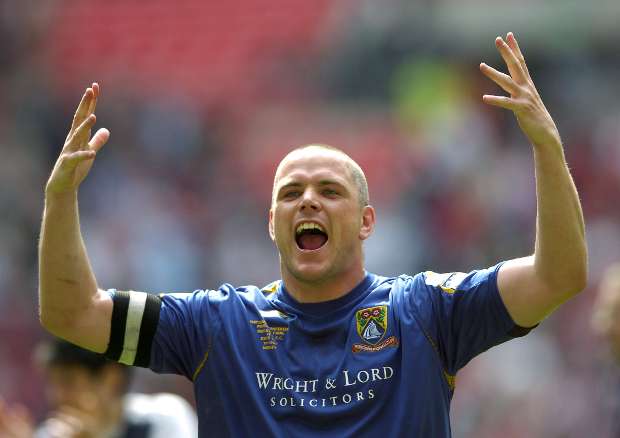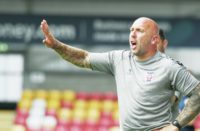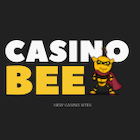BELIEVE it or not, there was a time in Non-League football when centre-halves used to wear black boots. In fact, everyone did, apart from the nippy winger who was just asking to be hoofed into the stand by the full-back.
Ah, them [sic] were the days. When a student could get into a Step 1 game for £4 and Forest Green keeper Steve Perrin would help himself to a chip as he walked back before taking a goal-kick.
At risk of getting all misty-eyed, the path for this reminiscence was set out by a question that popped up at NLP Towers recently. Who’s the best Non-League player you’ve ever seen live?
Not a Jamie Vardy or a George Boyd – this wasn’t about remembering the fleet-footed stars that danced past hapless defenders’ desperate attempts to scythe them down.
Showmen
We were talking about the proper Non-League players. The ones who may have Football League experience, but spent a lot of their days in the muck and nettles.
As someone who grew up watching Farnborough Town, legends like Dennis Bailey, Chris Booth and Sir Lenny Piper immediately stoke the memory. Booth with his disco pants and Piper the little midfielder with a golden touch.
Bailey was first at Cherrywood Road when I was still wearing nappies, before going on to become a quiz question in his QPR days after scoring a hat-trick against Manchester United at Old Trafford in 1992. The next player to bang in a treble in the European giants’ backyard? Ronaldo, the real one from Brazil, a full 11 years later.
Bailey returned in 1998, rattled a load of goals in for a struggling Boro side, including a majestic chip against Woking, and then title chasers Cheltenham Town nabbed him before the end of the season.
Farnborough were relegated and the Robins did finish up as champions, with a line led by Neil Grayson. Forest Green Rovers, Stafford Rangers, Heanor and Glapwell benefitted from his goals when he left Cheltenham, and Non-League’s very own Peter Pan even banged one in for Glapwell in the Central Midlands League on his 50th birthday.
Gary Abbott, Mark Cooper, Geoff Pitcher, Jon Challinor, all spring to mind too, as well as Roscoe D’Sane. Then there was the lethal Gregg Blundell, who was always a menace.
Opposition players would often pop into the bar after and mix with the fans. Blundell once got into a heated debate with a Farnborough fan about the game. But that’s what Non-League football is all about: swapping opinions.
Following Boro in the late 90s and early 2000s was interesting, to say the least. No money, a mystery owner who ended up in jail before the takeover was ratified, and the arrival of Graham Westley. It wasn’t quiet in north-east Hampshire and still isn’t.
But the Conference back then wasn’t the full-time league it is now. The majority of clubs were genuine part-timers with only a couple of big boys in town. And when they were, you knew about it.

Yeovil Town in their pomp especially. With an army of noisy, well-oiled supporters, their team would turn up and roll you over with unbelievable pace on the counter-attack and sharp shooting finishers. Kirk Jackson put Farnborough to the sword in 2002-03 when Gary Johnson took the Glovers into the Football League, and they had quality in Lee Johnson, Darren Way and Michael McIndoe.
Lethal
Not forgetting Rushden & Diamonds at their sparkly Nene Park stadium, compared to the usual rusting stands most clubs were used to. They also had class running through the side, but one of the lesser-mentioned must be Paul Underwood.
The left-back with flowing hair seemed to be outstanding every time I saw him. It always felt like the gulf between the part-timers and the Cheltenhams, Yeovils, Diamonds, Doncasters and Herefords of the time was just too large.
What about Dagenham & Redbridge and the epic title race of the 2001-02 season between Garry Hill’s side and Steve Evans’ Boston United?
Both played a lot higher, but the Daggers’ front two of Mark Stein and Ken Charlery provided experience as well as guaranteed goals. Between the sticks they had the immovable object of Tony Roberts, who had an unforgettable meltdown at Cherrywood Road once.
See in those days, you could throw a proper strop and get sent off without the risk of being a viral internet hit before you’d boarded the team bus. But Roberts was a proper keeper; you felt lucky to score past him, much like Paul Bastock, Steve Book at Cheltenham and Yeovil’s Tony Pennock – who later joined Farnborough.
Thanks to Boston’s, ahem, controversial accounting that landed boss Evans in the dock, that season will go down as one of the Conference’s most memorable. The Pilgrims won the league on goal difference and one of Non-League’s best ever hit-men, Daryl Clare, saw to that.
Boston is a long way from Farnborough. It’s an even longer way back when you’ve just been given a shoeing. Before the game, Clare swept up the Player of the Year awards.
So regularly was he called up to accept yet another gong, he often didn’t have time to get back to his warm-up before his name was announced again. In the end it became a running joke as he slowly left the presentation table, only to return by running backwards to bag his latest prize.
He scored that day as Boston handed out a 4-0 drubbing. He repeated the trick with Chester City, gobbling up 29 league goals as they returned to the Football League in 2004 and then smashed in a load more at Burton Albion. Unstoppable.
Well, unless he came across someone like Jim Bentley. The Morecambe centre-back was a barrel-chested grizzly bear, who looked like his diet mainly consisted of jumped-up Conference strikers.
‘Thou shall not pass’ may as well have been tattooed on his forehead. His reading of the game, his raw defending attributes and knack for heading the ball further than most people could kick it meant he had everything a lower league defender needed.
As well as a look that could kill. So imagine the surprise when reading a profile piece in our sister title The Football League Paper about what a gentleman the now Morecambe manager is.
On the pitch though, the towering defensive wall gets my vote as the top man among legends.




















